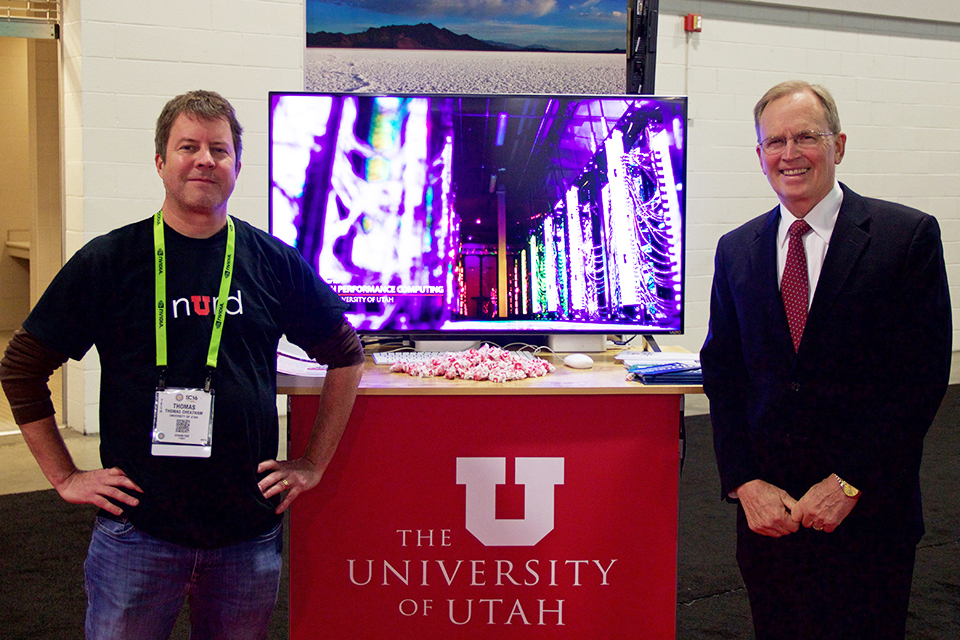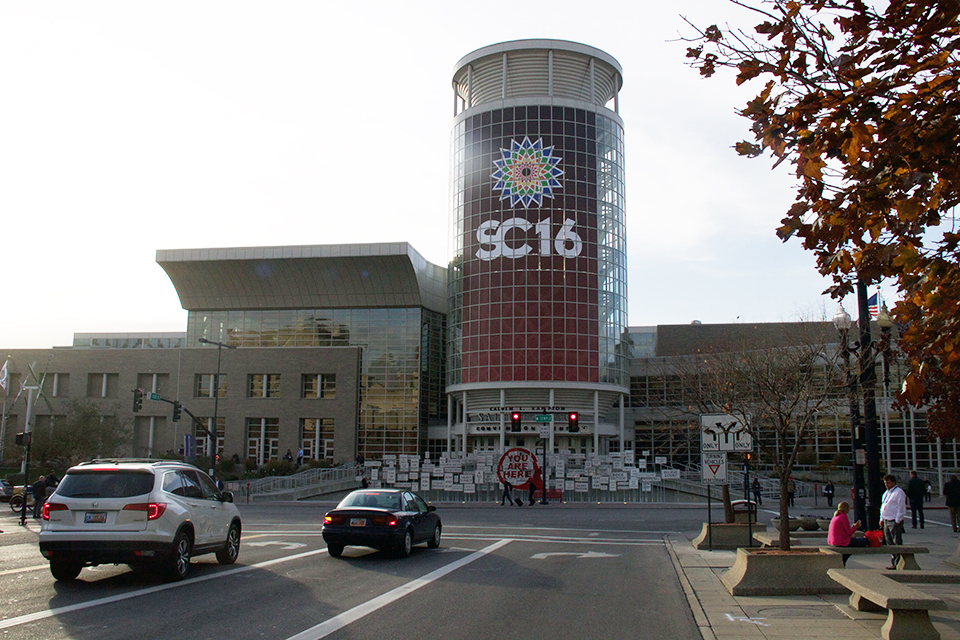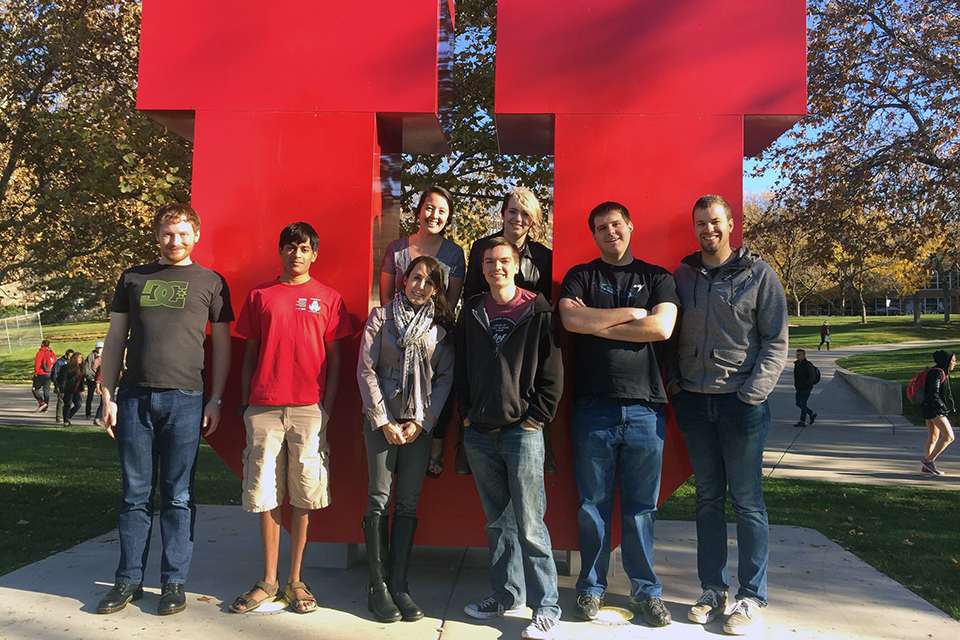You’re accessing archived content
This is archived content from the UIT website. Information may be outdated, and links may no longer function. Please contact stratcomm@it.utah.edu if you have any questions about archived content.
CHPC again reps the U at Supercomputing 2016
 |
| CHPC Director Tom Cheatham and Chief Information Officer Steve Hess at CHPC's booth November 15, 2016. |
UIT's Center for High Performance Computing (CHPC) once again represented the University of Utah at the 2016 Supercomputing Conference, an international gathering for people working with high performance computing, networking, storage, and analysis. SC16 took place November 13-18, 2016 at the Salt Palace Convention Center.
This year's conference was the largest in its 28-year history, drawing a record 11,100 registered attendees and 349 exhibitors, according to a press release.
CHPC's booth, designed by Senior Systems Administrator Sam Liston, was an open, lounge-type space with seating to accommodate ad-hoc meetings with peers and vendors.
“It’s primarily a place to interact with our counterparts,” said Anita Orendt, CHPC's Assistant Director for Research Consulting and Faculty Engagement.
The collaborative space was also staffed by colleagues from Brigham Young University and Utah State University.
In addition to showcasing CHPC activities and partnerships, a running slideshow highlighted computationally-intensive research conducted with resources from CHPC and the U's Scientific Computing and Imaging Institute (SCI). Featured projects included an air quality simulation in conjunction with the Utah Division of Air Quality (UDAQ) and Giggle, a scalable, multi-file index for fast queries of genomic intervals sponsored by USTAR Center for Genetic Discovery.
The conference is an opportunity to network, attend workshops, and learn about the latest advances in high performance computing.
In addition to industry leaders heralding latest developments, CHPC Senior IT Architect Brian Haymore said the conference is a place where students, researchers and research interests share work they’ve accomplished during the conference's technical program.
 |
| The Salt Palace Convention Center played host to the SC16 conference. |
"Over the years, these presentations have revealed some of the earliest stages of what might well become the next big thing," Haymore said. "That allows us to bring these things back to the U campus and integrate them much earlier in their lifecycle then we would otherwise. And that translates into increased opportunity for our researchers to have competitive proposals as they submit for research grants."
Orendt said the lessons learned are as varied as the conference attendees.
"If you talk to any one of us, you find someone has a different takeaway, and something they’re going to try in the next month or two," she said.
Haymore lauded the latest Pascal-based GPUs from NVIDIA, and the company’s NVLink, a high-bandwidth, energy-efficient interconnect he said will further improve scaling for many applications that can leverage GPUs. Other products Haymore feels are suited for CHPC applications include Intel and Mellanox’s 100Gbit/s networking technologies and Intel’s latest Xeon Phi architecture.
The takeaway for CHPC Systems Administrator David Heidorn was to get a better feel for how Hadoop fits into scientific computing at the U. Hadoop is an open source, Java-based programming framework that supports processing and storing large data sets in a distributed computing environment.
"I'd like to run more analytics to determine who’s actually using Hadoop and how often it’s actually getting used,” Heidorn said. "There's a growing interest in moving Hadoop from where it traditionally is to HPC."
 |
| The "SupercompUtes" Student Cluster Competition team, front row, from left: Mark Baranowski*, Liam Machado, Janaan Lake*, Kincaid Savoie*, Kevin Parker*, and Brandon Caywood*. Seated in back are Kara Douville and Hannah Eyre*. * Team members who competed. |
For the first time, the Student Cluster Competition included a team from the University of Utah – the "SupercompUtes" – mentored by School of Computing Professor Mary Hall and Assistant Professor Hari Sundar, with CHPC’s Haymore providing advising help. CHPC staff members assisted with designing the cluster, housing it, and providing space for the students to work.
The real-time, non-stop, 48-hour challenge tasked 14 student teams with designing and building a cutting-edge, commercially available cluster able to accommodate a variety of HPC workflows while constrained by the 3120-watt (26-amp) power limit. For a real-world twist, teams were subjected to a surprise power outage.
The SupercompUtes finished a close second behind a team from the University of Science and Technology of China.
"Most of the other teams have been doing this for a number of years, so finishing in second place by only a slight margin was a great accomplishment," Haymore said.
SC17 will be held November 12-17, 2017 in Denver, Colorado.
Node 4
Our monthly newsletter includes news from UIT and other campus/ University of Utah Health IT organizations, features about UIT employees, IT governance news, and various announcements and updates.
